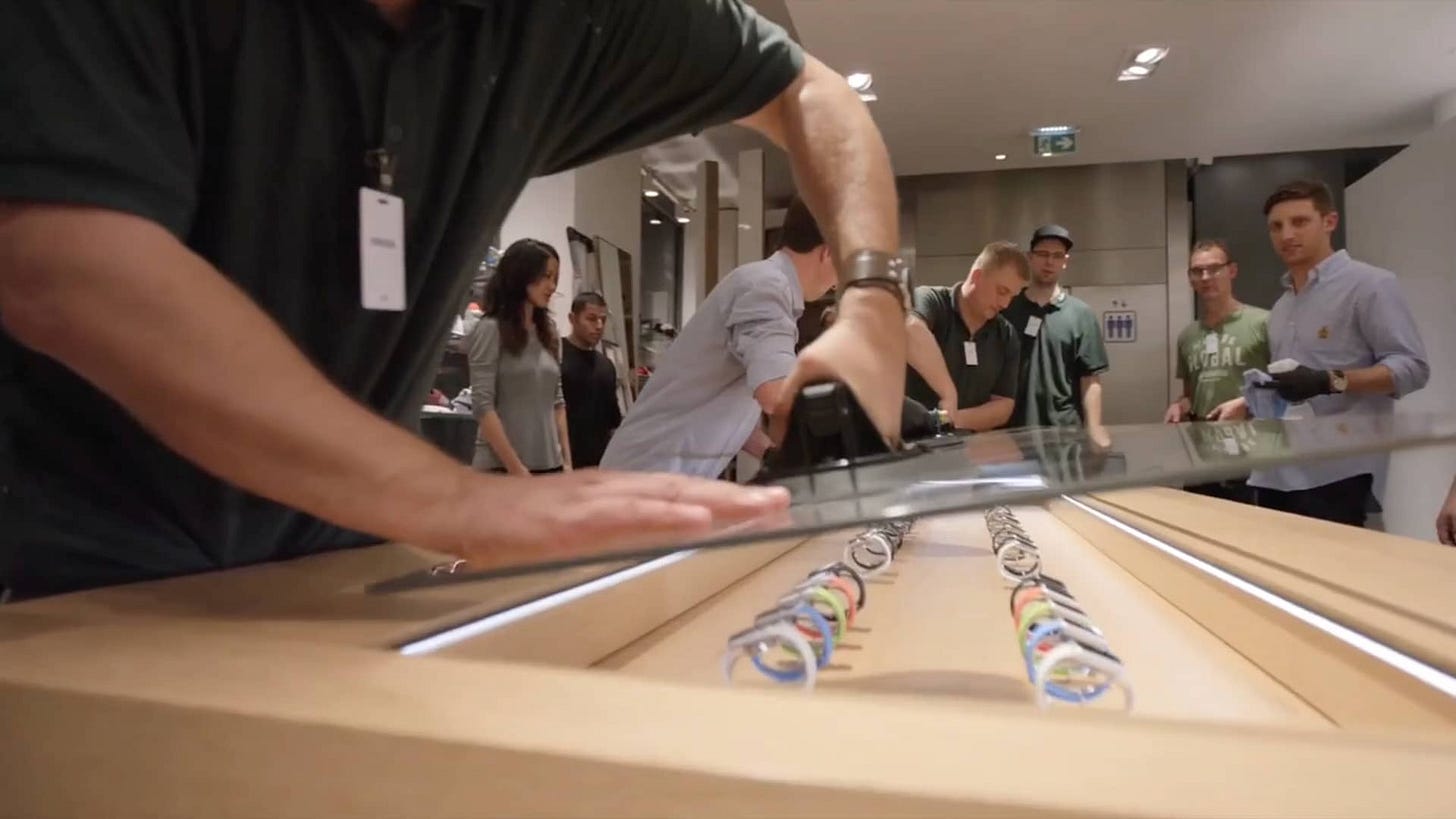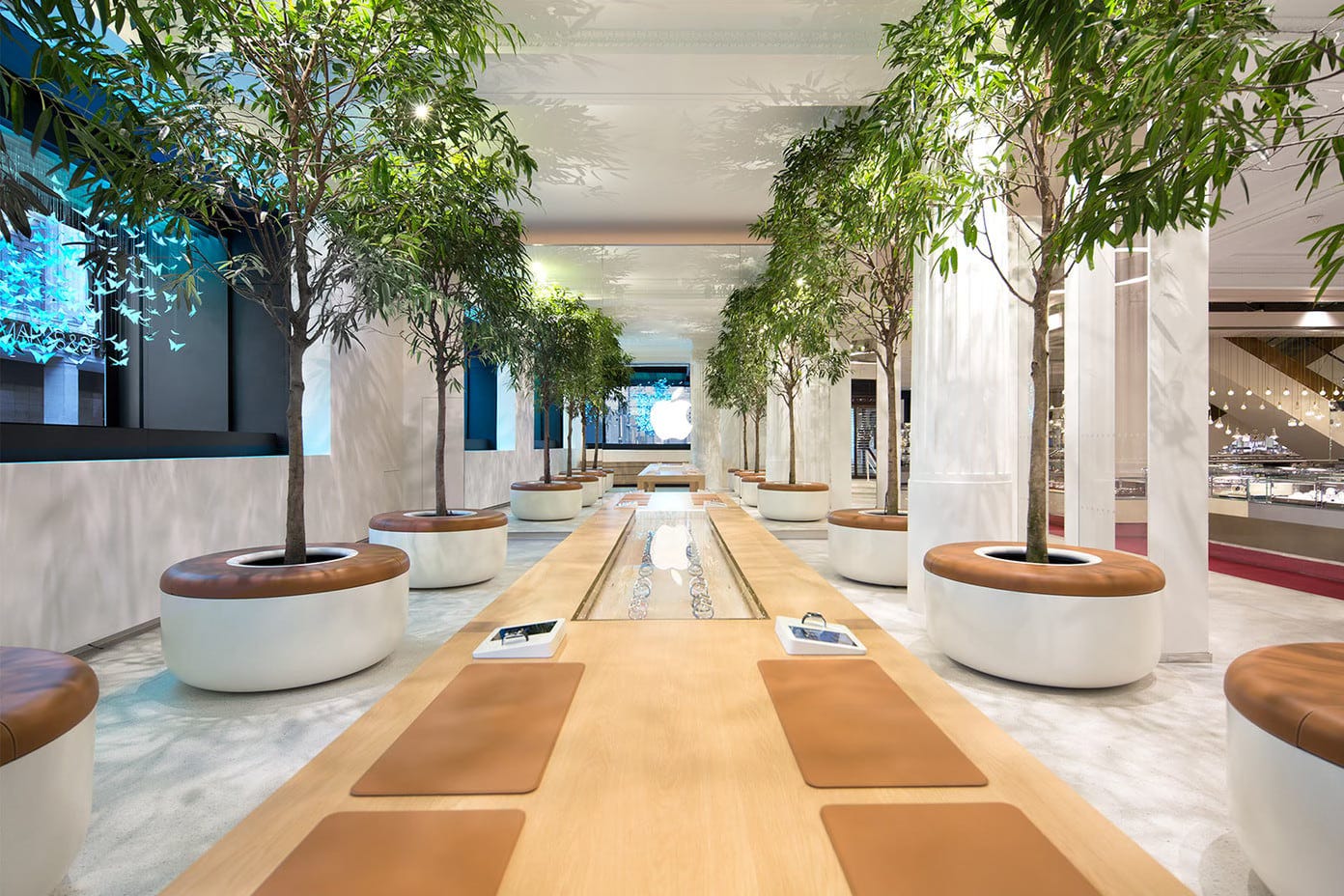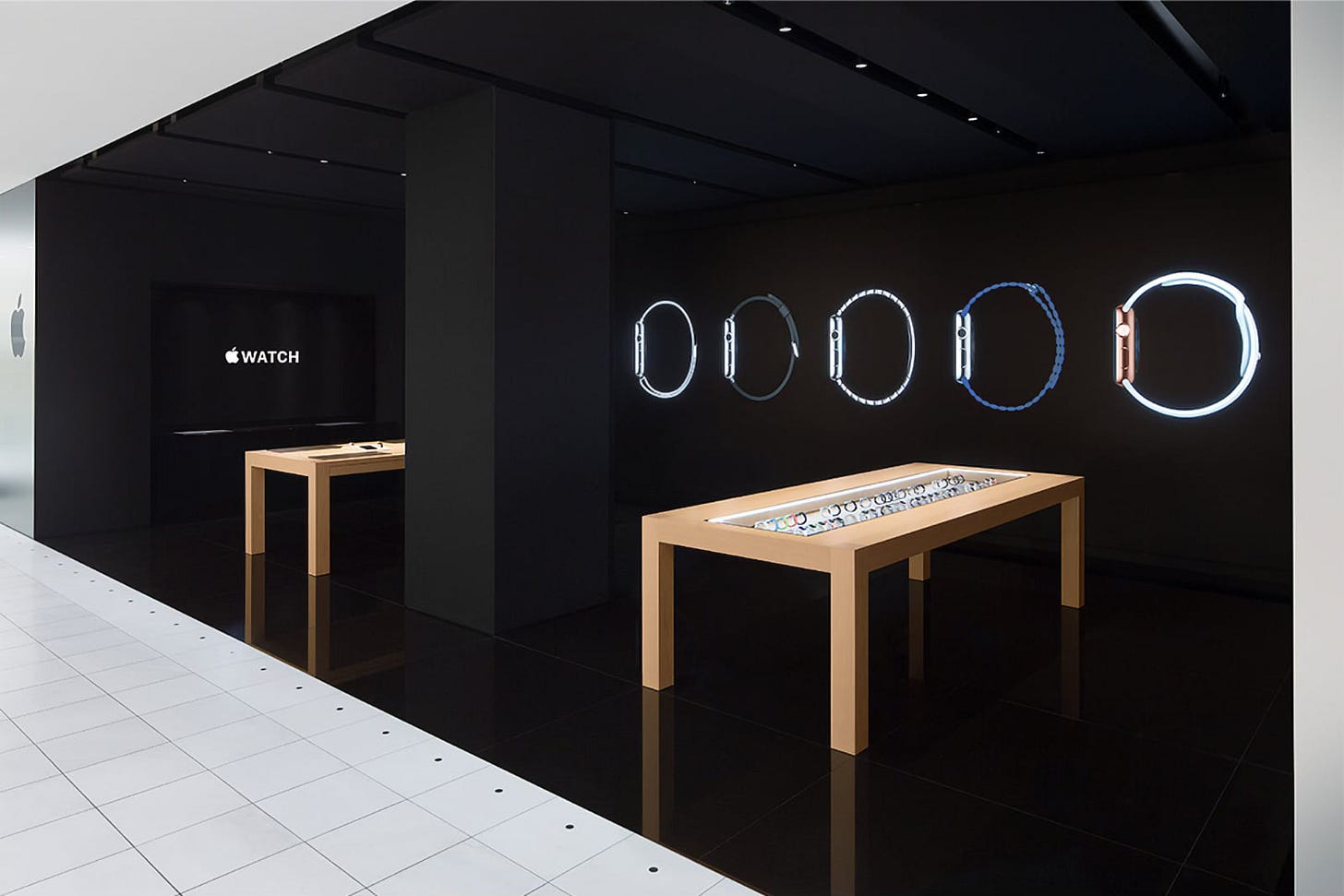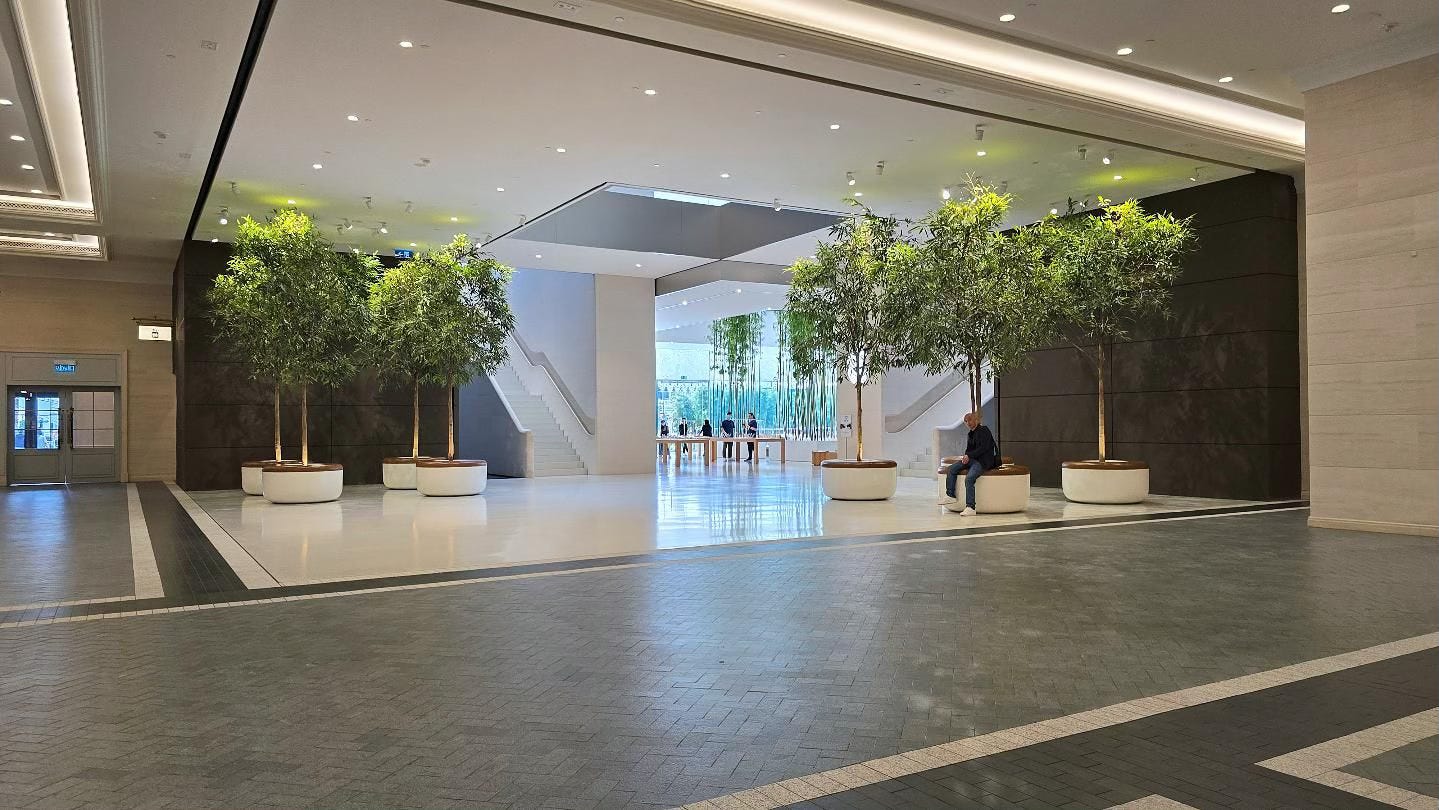On April 10, 2015, Apple began a public preview of the first Apple Watch in nine countries. Customers could schedule an appointment with a Specialist to try on a watch and browse the range of bands and collections: Apple Watch, Apple Watch Sport, and Apple Watch Edition.
As if outfitting a global network of stores with the tools and knowledge to demo a new product category wasn’t challenging enough, Apple tried something totally unproven — opening pop-up shops. Nine years have slipped by, and much of this history is at risk of being forgotten and lost. It’s time to put some of it on the record.

To understand the story of Apple Watch Shops, one must first recall the Apple Retail environment a decade ago. Angela Ahrendts began her role as senior vice president of retail and online stores in May 2014, and Apple was in the heady days of a long relationship with Foster + Partners. Apple Park was under construction, and Apple Stores were emerging from the Browett fog. Within just over a year, the entire store experience would be reimagined.
The 18-karat gold Apple Watch Edition was an expensive luxury product, but Apple Stores were always meant to be egalitarian places. To capture a new audience, Apple needed to branch out. Perhaps the act of creating a product fundamentally unfit for the retail spaces designed to sell Apple products should’ve been the first sign that the Edition was a distraction, but I don’t look back on it as a mistake. Wearable computers were still on the fringes of social acceptance in 2014, and premium Apple Watch models helped shift the conversation.

On September 30, 2014, Apple hosted a one-day event at Paris boutique Colette. This was an important moment for Apple Retail, though the event is remembered today chiefly for its appearances by Jony Ive, Marc Newson, Karl Lagerfeld, and Anna Wintour. It was at Colette that Apple staged its first customer test of the glass-topped Apple Watch display table that became ubiquitous in Apple Stores for seven years. The table was briefly unveiled three weeks prior in the tightly controlled media demo area at Cupertino’s Flint Center.

The event played out much like a new store opening or product launch at a real Apple Store: blacked out windows beforehand, an amazing new window display, and souvenir cards for the first visitors. This video offers a rare glimpse at what it took to make the event at Colette happen.
Apple Watch hype cooled over the fall and reignited in the new year. On February 18, 2015, a rumor claimed Apple would open an Apple Watch shop in Galeries Lafayette Haussmann, a celebrated department store in Paris. (This is an Internet Archive link to the original rumor, which will only work if you’re reading this post on the web.) On February 28, a separate rumor suggested a pop-up was also coming to Selfridges on London’s Oxford Street, another famed department store.

Both shops hired internally, recruiting employees from nearby Apple Stores to make the move. Construction photos from inside the Paris space surfaced. On March 9, Apple announced the shop-in-shop plan, which included Apple Watch availability in boutiques like Dover Street Market, and on the 15th, Japanese blog Mac Otakara published photos of the third Apple Watch pop-up preparing to open inside Tokyo’s Isetan Shinjuku department store. A black construction wall announced the shop’s April 10 arrival. Later in March, photos were published of similar barricades in London and Paris.
iGeneration reported that Apple had to make several concessions to sell at Galeries Lafayette. Employees were to follow the building’s dress code, and transactions were completed using the department store payment system. The same was true at Isetan Shinjuku.
On April 10, the shops were revealed and appointments began. The Verge sent reporters to all three locations:
Apple's slice of real estate [inside Galeries Lafayette] was comparatively small, with four sections of long wooden tables — much like what you'd find in any typical Apple Store, save for the Chanel and Dior stands that bordered it. The watches were displayed under glass along the wooden tables, with some working models available for people to try out. Each section was organized by watch model and divided by tall, Apple Watch-branded barriers. (The final section was devoted to iPhones.) Other watches are stored in the tables' RFID-controlled drawers, but the high-end Edition models were kept in an undisclosed location elsewhere in the store. An Apple employee who helped me try one on cited security reasons for the separation.

To try a watch at an Apple Store or an Apple Watch shop, you could schedule an appointment on Apple.com beginning April 10. Using the Internet Archive version of the page, you can still select a store and see which locations offered Apple Watch Edition.
Each Apple Watch shop had a unique layout with unique fixtures, but all three locations shared a unified goal. It’s hard to overstate how many designs that would later became standard store elements were first piloted here. Apple Watch at Selfridges was located at the Wonder Room, a luxury space reserved for jewelry and watches. Here, Apple fabricated an oversized 8-meter display table that was nearly three times the length of a standard table. Oversized tables were later used at significant stores like Fifth Avenue, Third Street Promenade, and Valley Fair. On the table were saddle brown leather mats (standard Apple Stores initially used midnight blue mats) and rare iPhone and Apple Watch band trays that never made their way to other stores.
The Selfridges space was lined with trees with integrated leather seating — another first for Apple. More than a year later, these planters would become the foundation of the Genius Grove concept. Apple filed a patent for a planter on February 9, 2015 — just over a week before the watch shops were first rumored.
The floor at Selfridges appears to be terrazzo, which would indicate that Apple poured a new floor for this temporary shop. General Contractor Empty noted that, “The additional load on the slab of the department store required new steel beams to be installed underneath.”
Apple Watch at Galeries Lafayette occupied a balcony space on the first floor. This shop reminds me a bit of Apple Grand Central. Apple didn’t do much to the building itself because the surroundings were already so fantastic. Tables were arranged in groups of two on an arc following the curve of the railing. The tables sat on top of curved rugs reminiscent of those used in Apple Vision Pro demo zones. Sections were split by prototype Avenues — the first and only fixtures of their kind ever manufactured for an Apple Retail space. Remember, this was two months before Apple Upper East Side opened with a pilot design.

The Galeries Lafayette space was a merchandising laboratory. Apple trialed several concepts here that were never seen again. At one Avenue, 180 individual iPhone cases filled the bay. Under one display table, boxed Apple Watch Edition models were displayed on gray (Rose Gray?) leather mats. Under another, every model of iPhone 6 (cased and uncased) was mounted both screen side and back side up. Some of the prototypes Avenues had displays built into their counters.
Apple Watch at Isetan Shinjuku was both the most familiar and most peculiar shop. The space resembled a standard Apple Store with counters, walls, a ceiling, and tables designed by Apple, but the interior was totally black. In some photos, the shop looks almost Vantablack, though I’m not sure it felt quite that dark in person. More peculiar: stretched across the back wall was a massive, video wall-sized graphic panel. This same basic concept first reemerged in May 2023(!) at Apple Tysons Corner. Most peculiar: The Galeries Lafayette and Selfridges shops were both assigned store numbers — R658 and R659, respectively. I’ve never managed to link a store number to Isetan Shinjuku.

A key part of the Apple Watch shop and Apple Store preview experience was the Apple Watch Demo display. This device was a white, glass and acrylic wedge fit with an iPad mini and a functional Apple Watch.

In the early days, the watches available to try on ran a simple software demo loop. The display fixture allowed you to learn how to navigate watchOS. The demo watch and integrated iPad were paired: opening an app on the Apple Watch displayed contextual information on the iPad. The iPad ran an app called Apple Watch Demo, which was codenamed Hogwallop. A patent for the demo display fixture was filed on February 27, 2015.
The Apple Watch shops weren’t just bold experiments, they were canvasses for some of the most striking and creative window displays Apple ever created. Rather than attempt to catalog the images here, I encourage you to check out this post by my friend Filip, who’s already captured the era beautifully.

There was one more Apple Watch shop — kind of. On April 17, 2015, Apple hosted a one-day pop-up during Salone del Mobile, Milan’s annual furniture fair. The demo area was essentially comprised of a few display tables placed in the center of the emptied Carlo e Camilla en Segheria restaurant, and an elaborate entrance pavilion was constructed to guide visitors into the building. It’s hard to believe this space existed for just 10 hours.
In October 2016, A report stated that Apple Watch at Galeries Lafayette would soon close. On or around January 3, 2017, Apple Watch at Selfridges closed without fanfare. The Paris shop followed on January 21. The closures seem predictable and natural, though poor sales are thought to be a contributing factor. It’s hard for me to imagine that Apple ever planned for these spaces to become permanent stores.
In November 2017, Apple Watch at Isetan Shinjuku disappeared from Apple.com, but the shop remained open. The death knell came in April 2018, when Apple Shinjuku opened in a building literally across the street from the Isetan Shinjuku department store. One month later, on May 13, 2018, the last Apple Watch shop closed.

Leading up to the closure, Apple began selling new old stock of the original Apple Watch Edition at wildly reduced prices — up to 70% off! The discounts culminated in a fire sale on the Isetan website where 38mm gold watches were slashed from $10,000+ to just $700.
Within a few years, Apple opened a new permanent store near the site of every Apple Watch shop: Apple Champs-Élysées in Paris (which offered an exclusive Hermès band room), Apple Brompton Road in London, and Apple Shinjuku in Tokyo. Apple Piazza Liberty opened within similarly proximity to the Salone del Mobile pop-up space. Had these stores been ready in 2015, I wonder if the Apple Watch shops would’ve existed at all.
The maturity and ubiquity of today’s store fleet means that Apple doesn’t need to branch out for new product introductions. Apple Vision Pro demo zones proved as much. The 2015 Apple Watch launch was a brief moment where dreams outpaced the speed of reality.
Featured image
Apple Cotai Strip
Photo via @crmallillin.







That was me at Isetan Shinjuku for The Verge! It all feels a little OTT in hindsight but it was exciting at the time.
I can confirm that the store felt really, really black. I called it "the evil twin of the company's regular stores" in a photo caption.